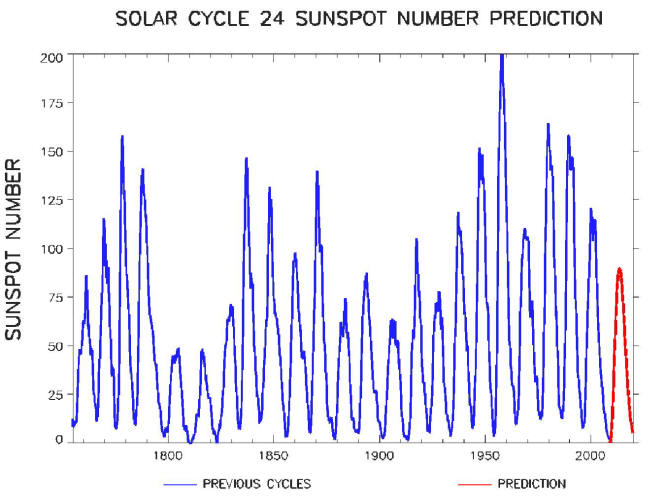|
|
|

Credit: NOAA/Space Weather Prediction
Center(SWPC)
Riding the Solar Cycle
Apr
15, 2010
New studies are
confirming the connection between
Earth and the Sun.
Recent Picture of the Day articles
have addressed the many issues that
make understanding the Sun
exceptionally difficult. There are
serious dichotomies between the
consensus viewpoint about solar
activity and the Electric Universe
viewpoint. In particular, the
hypothesis popularized in Professor
Don Scott's book,
The Electric Sky is
diametrically opposed to the
thermonuclear hypothesis first
described by
Sir Arthur Eddington in 1926.
It is in just the past few years
that planetary scientists and
meteorologists have begun seeing the
effects of the Sun on our climate.
Now,
according to scientists from the
National Center for Atmospheric
Research (NCAR), analyzing sunspot
records for the past 100 years has
revealed a pattern of effects that
have not been incorporated into
climate models because they were not
previously recognized in the data.
It appears that the Sun's 11 year
cycle of increased and decreased
output is linked to the severity of
weather events, such as hurricanes
or droughts. Although solar energy
does vary over the course of a
sunspot cycle, that variance amounts
to less than one-tenth of one
percent, far too little to account
for the intensity seen in storm
systems or the increased regions of
drought.
The amplification of the solar
energy's influence on Earth's
climate could not be explained
through current theories, so another
solution was suggested. As the new
theory explains, increased solar
energy output during maximum sunspot
production warms up the tropical
stratosphere since sunlight impinges
most directly on our planet close to
the equator. Other factors are
involved, but the ultimate
conclusion is that the atmosphere
warms unevenly, becoming hotter near
the equator and cooler in the higher
latitudes.
This uneven thermal distribution
causes increased atmospheric
convection, resulting in greater
tropical precipitation. Combined
with convection, the extra solar
energy heats the waters of the
Pacific Ocean, where, it is said,
more clouds form in an area where
they are normally absent. The clouds
then flow west along the more
powerful convection currents (the
trade winds), where they increase
the effects of the stratospheric
heating.
As with most other theories, the
climate model suggested by the NCAR
investigators is based on kinetic
energy: heat and the movement of the
atmosphere. Nowhere in the
scientific press is it acknowledged
that electric currents and the
strength of the ion flux from the
Sun are the primary drivers of
climate fluctuation.
As Electric Universe theorist
Wal Thornhill wrote:
"A star is the focus of a galactic
'glow discharge.' The electrical
energy that courses through the
solar system and powers the Sun is a
subtle form of energy that all of
the planets intercept to some
degree. Planets orbit within this
discharge and intercept some of the
electrical energy. Planets are minor
'electrodes' within a stellar
discharge envelope. The electrical
energy is delivered to stars and
planets in the manner of a simple
Faraday motor."
Since water is a dipolar molecule,
the effect of ions as attractors for
water vapor was evident. That and
Wal Thornhill's information about
thunderstorms acting as "leaky
capacitors" leads to the observation
that there are enormous fields of
ions in transparent haloes around
clouds:
Electric Clouds
It is now evident that those ion
fields are linked to the cosmic ray
connection illustrated by Henrik
Svensmark in his work with cloud
chambers.
From
The Cloud Mystery website:
"One effect of solar changes
[sunspots] is to vary the number of
cosmic rays reaching the Earth from
the Galaxy. In 1995 Henrik Svensmark,
also in Copenhagen, began to wonder
if the cosmic rays could affect
cloud cover. When he compared
satellite observations of clouds
with the varying counts of cosmic
rays from year to year, he found an
amazing link. A stronger Sun and
fewer cosmic rays meant fewer clouds
and a warmer world. Friis-Christensen
agreed with this explanation for the
Sun's role."
Stephen Smith
|
|
|
|
|
|
|
|
|
YouTube video, first glimpses of Episode Two in the "Symbols of an Alien Sky"
series.
|
|
|
|
|
|
|
Three ebooks in the Universe Electric series are
now available. Consistently
praised for easily understandable text and exquisite graphics.
|
|
|
|
|
|
|
|
|
|







